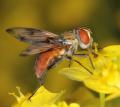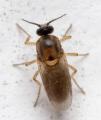Diptera.info :: Family forums :: Syrphidae
|
Two syrphid flies
|
|
| Juergen Peters |
Posted on 28-04-2005 22:33
|
|
Member Location: northwest Germany Posts: 14212 Joined: 11.09.04 |
Hello! I fotographed these two syrphid flies today on a meadow near a small forest in Ostwestfalen/Germany. Can someone be so kind to help me identifying them? Thanks in advance! The first one was rather tiny (6-8 mm):  A little bigger (somewhat between a house fly and a small Eristalis) the second one visiting Taraxium blossoms:  Best regards, Jürgen -=-=-=-=-=-=-=-=-=-=-=-=-=-=-=-= Juergen Peters Borgholzhausen, Germany WWW: http://insektenfo... -=-=-=-=-=-=-=-=-=-=-=-=-=-=-=-= |
| Gerard Pennards |
Posted on 28-04-2005 22:54
|
|
Member Location: Amersfoort Posts: 1914 Joined: 07.06.04 |
Hello Juergen, I think I can help you! :-)) The first picture is the female of Parasyrphus punctulatus. Normally the spots on the abdomen are quite characteristic, but in this picture they are more difficult too see. But I am quite sure it is this species. The second is very nice! It is a male of the species that was formerly known as Megasyrphus annullipes or Megasyrphus erraticus. Nowadays it belongs in the genus Eriozona, so this is a male of Eriozona erraticus! Greetings, Greetings, Gerard Pennards |
|
|
|
| Arthropa |
Posted on 28-04-2005 22:56
|
|
Member Location: Fragnes (Burgundy, France) Posts: 183 Joined: 15.06.04 |
Hello, I was about to try to give some answer, but Gerard was more rapid !  I thought the second fly was some Syrphus sp.  What makes the difference ? What makes the difference ?Edited by Arthropa on 28-04-2005 22:59 Benoit MARTHA  |
| Gerard Pennards |
Posted on 28-04-2005 23:34
|
|
Member Location: Amersfoort Posts: 1914 Joined: 07.06.04 |
Hello Benoit, There are a few differences between this one and Syrphus sp. The first and most important one is the curved vein R4+5 in the wing (as in Eupeodes lapponicus), in Syrphus this vein is straight. Second, the shape of the spots on the abdomen is typical, with the curved spots on segment 2, and the bands on 2 and 3 with the typical 'bite' out in the middle. Third, but maybe not so visible in the picture is the dark, shiny thorax, in Syrphus this is more green/yellowish and dull. Last but not least, the species has a black spot just above the antennae. These are the most obvious differences! Greetings, Greetings, Gerard Pennards |
|
|
|
| Juergen Peters |
Posted on 29-04-2005 01:53
|
|
Member Location: northwest Germany Posts: 14212 Joined: 11.09.04 |
Hello, Gerard! Thanks alot for your help! Gerard Pennards wrote: The first picture is the female of Parasyrphus punctulatus. Ah yes. I had taken a picture of this species a few days ago at another place, but was not quite sure if this one was the same. The second is very nice! It is a male of the species that was formerly known as Megasyrphus annullipes or Megasyrphus erraticus. Nowadays it belongs in the genus Eriozona, so this is a male of Eriozona erraticus! Interesting! I had this species (I think) in last August, but the stripes seemed to be a little narrower and more pure yellow:  Best regards, Jürgen -=-=-=-=-=-=-=-=-=-=-=-=-=-=-=-= Juergen Peters Borgholzhausen, Germany WWW: http://insektenfo... -=-=-=-=-=-=-=-=-=-=-=-=-=-=-=-= |
| Gerard Pennards |
Posted on 29-04-2005 07:56
|
|
Member Location: Amersfoort Posts: 1914 Joined: 07.06.04 |
Hello Juergen, Yes, this is the same species, but in this case it is the female! By the way, I should correct myself, the name is not E. erraticus, but it should be Eriozona erratica! Greetings, Greetings, Gerard Pennards |
|
|
|
| Juergen Peters |
Posted on 29-04-2005 18:44
|
|
Member Location: northwest Germany Posts: 14212 Joined: 11.09.04 |
Gerard Pennards wrote: Hello Juergen, Yes, this is the same species, but in this case it is the female! By the way, I should correct myself, the name is not E. erraticus, but it should be Eriozona erratica! Greetings, Thanks, Gerard! Best regards, Jürgen -=-=-=-=-=-=-=-=-=-=-=-=-=-=-=-= Juergen Peters Borgholzhausen, Germany WWW: http://insektenfo... -=-=-=-=-=-=-=-=-=-=-=-=-=-=-=-= |
| Arthropa |
Posted on 29-04-2005 22:32
|
|
Member Location: Fragnes (Burgundy, France) Posts: 183 Joined: 15.06.04 |
Thanks for your explanations, Gerard !... ...and please let's go further for newbies like I am !  So, if I understood your explanations, with a R4+5 straight vein and yellowish thorax, this one should be some Syrphus sp? Right ?  Saint Apollinaire (Burgundy, France), 21th April 2005 - body length 9 mm Benoit MARTHA  |
| Gerard Pennards |
Posted on 29-04-2005 22:46
|
|
Member Location: Amersfoort Posts: 1914 Joined: 07.06.04 |
Hello Benoit, Yes, you pick up the syrphid lessons quite well!    This is indeed a male Syrphus sp., you can compare it with the photo that Juergen submitted, than you will see the differences I mentioned. Greetings, Greetings, Gerard Pennards |
|
|
|
| Arthropa |
Posted on 29-04-2005 23:14
|
|
Member Location: Fragnes (Burgundy, France) Posts: 183 Joined: 15.06.04 |
I've always needed good teacher to understand lessons !  Very kind of you. Best regards. Benoit MARTHA  |
| Jump to Forum: |













